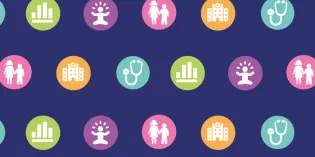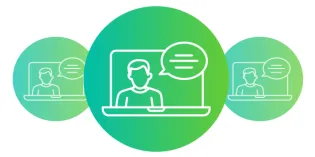
An integrated service can only make that claim when those most in need feel their care is both personalised and joined up.
We are becoming increasingly aware of the complexity of care and how difficult it can be to deliver the most basic service or pathway.1 2 The excellent RCPCH St David’s Day conference, curated by our trainees, took on the theme of integrated care to help address complexity. We learnt of a myriad of high-value services, in health and community, and the collaboration between them, but it's clear we are still in the foothills of integration in child health.
Drs Gemma Ford, Georgia Morgan and Elin Powell organised the day around four themes - unmet healthcare needs of children and young people (CYP); the primary and secondary care interface; the language of childhood weight management; and early years. There were 18 presentations, including breakouts from 33 presenters that all came together in a cohesive whole.
A voice for all
Collaboration between maternity and neonatal services are well established, but integration begins well before conception and does not stop for months or years (if ever) after. This was highlighted in talks addressing public health, maternity, neonatal services and parental care, while the team from Cwm Taf Morgannwg captured the need for infants' rights to ensure we are addressing every child’s needs and not just those who appear before us in special care, on the ward or in a clinic.
This team has taken a Scottish framework “The Infant Pledge”3 to develop a tool to hear “The Baby and Toddler Voice”4 to give the best start to life for everyone. Seems strange we have to do this when we spend considerably more on the first year of life than we do at any other time in paediatric services. Clearly there is more to it than just funding. And on this point check out the much needed Toolkit to Support Parental Engagement in Wales launched by Children in Wales this month.5
Prudent language
A shared language is critical to collaboration, and especially integration, when a false word in part of the system can easily undermine existing work elsewhere and send the patient and family into a tailspin.6 This is as true in weight management7 or in any service caring for vulnerable children and young people.
In the workshops we quickly recognised how our language had to change to avoid objectification and a panel of collaborators, spilling off the platform, developed joined up themes from public health to tertiary care although on this occasion we couldn't be joined by a teacher or pupil and the variation in care across Wales was all too apparent.
The voice of parents
An effective integrated approach shouldn’t leave anyone embattled, but is sadly too common in the many CYP with unmet or complex needs. The account of a parent, and one of our colleagues, of the difficulties accessing care for her son left us with much to ponder. Such apparent ambivalence may be attributed to insufficient scientific understanding or seemingly unrelated factors, but as shown in other talks a systems approach can manage uncertainty, even at scale, consider the profound effects of trauma, address need through schools and find community solutions, such as Platfform,8 to bridge an unhelpful divide between mental and physical health.
If you can’t navigate an integrated care system, it isn't a system
Or is it all about the numbers?
Integrated care, as opposed to collaboration, also brings the opportunity for efficiency. This may appear to be a numbers game but the rich debate on the primary and secondary care interface raised so much more. Data from 2007-2017 shows twice as many CYP contacts with GPs than in paediatric services with a subtle trend to increased hospital referral,10 and our highly experienced panel members - a GP, paediatrician and ED consultant - described longer paediatric waiting lists, an increase in frequent attendances to emergency care, and a marked fall in GP numbers, without getting into lack of other community health staff.
Two of five known interfaces in child health11 were presented - general practice outreach, and advice and guidance. Both appeared very attractive with one requiring more initial engagement and commitment than the other. However the debate continued to cover the importance of shared responsibility, the need for a common outcome framework, upskilling GPs, development of relationships that “oiled the works” and taking specialist care to the patient.
Collaboration or integration
It is clear we cannot do everything ourselves. Collaboration offers so much from linking in with other expertise, engaging new perspectives, sharing information and cooperation while maintaining professional autonomy and value.
In an integrated system this last point may be blurred by sharing of roles and responsibilities but with care and effective leadership integration improves cooperation, finds new common values, protocols and pathways making it easier for everyone, patients and families included, to work towards the same holistic patient outcome.
If you attend the conference and after reading this blog you’re inspired to take the lead on St David’s Day 2026, make sure to get in touch with enquiries-wales@rcpch.ac.uk.
- Case study
-
Despite my best efforts I get language wrong all the time. I may have inadvertently written a patient “failed treatment”, when the treatment had failed them or that the parent claims a pain score of 10/10 but I have not been told the doctor claimed he heard a diastolic murmur.
I can’t remember exactly what I said to a 12-year-old girl with long standing pelvic pain and her mother who had been bounced around services for many years, but I could tell from a slightly tense tone that I may not have been helping the situation. As a result I began to write verbatim phrases and check in with them both that they were accurate. I then copied a draft letter to them for comment and spoke on the phone for their amendments before committing to file.
I think it helped. Well, at least they came back.
- 1www.rcp.ac.uk/media/r33nczpf/nrap_wales-primary-care-clinical-audit-report.pdf
- 2Piroddi et al Identifying households with children who have complex needs: a segmentation model for integrated care systems. BMC Health Serv Res. 2025;25:152
- 3www.gov.scot/publications/voice-infant-best-practice-guidelines-infant-pledge/pages/14/
- 4www.childreninwales.org.uk/professionals/our-work/early-years/baby-voice/listening-voice-baby/
- 5www.childreninwales.org.uk/news/new-consultation-toolkit-launched-support-parental-engagement-wales/
- 6Cox C, Fritz Z. Presenting complaint: use of language that disempowers patients BMJ 2022; 377 :e066720
- 7hampshirecamhs.nhs.uk/video/things-not-to-say-to-a-fat-person/
- 8platfform.org/projects/life-work-and-wellbeing/young-people/
- 9www.nhsconfed.org/articles/if-you-cant-navigate-integrated-care-system-it-isnt-system
- 10Ruzangi et al, Trends in healthcare use in children aged less than 15 years: a population-based cohort study in England from 2007 to 2017 BMJ Open 2020;10:e033761
- 11Woodman et al, Integrating primary and secondary care for children and young people: sharing practice. Archives of Disease in Childhood 2016;101:792-797










